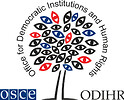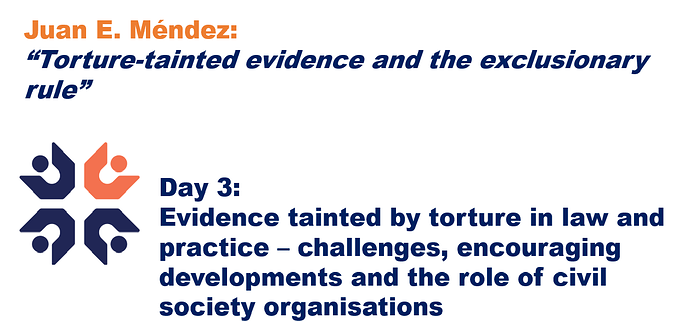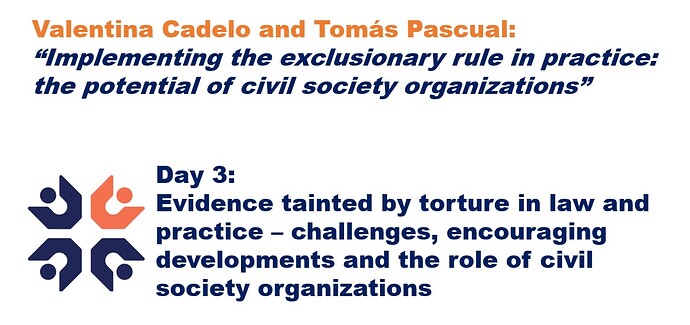Introduction
The inadmissibility of evidence obtained by torture (also known as the “exclusionary rule”, and found in Article 15 of the UNCAT) is a crucial aspect of States’ obligations to prevent torture. It removes one of the main incentives for law enforcement officials to use torture or ill-treatment – to elicit confession. Further, in the words of the UN General Assembly, the “adequate corroboration of statements, including confessions, used as evidence in any proceedings constitutes one safeguard for the prevention of torture and other cruel, inhuman or degrading treatment or punishment” (GA Res 67/161 of 20 December 2012, para 16).
The main responsibility to ensure implementation of the exclusionary rule lies with the different state institutions, as the State is the primary bearer of the duty to prevent torture. However, many other actors, such as civil society organisations (CSOs), play a critical role in the effective implementation of this rule and, accordingly, further contribute to prevent torture in practice.
Against this background, this blog post provides a few reflections on how CSOs involved in the area of torture prevention may actively contribute to ensure the prohibition of evidence tainted by torture is better applied in law and practice.
Drawing on the experience acquired by the Association for the Prevention of Torture (APT), this contribution highlights the critical role that CSOs play while:
Intervening as a third party in the courts’ review of domestic regimes to ensure compliance with existing standards on the prohibition of evidence tainted by torture and its effective implementation in law and practice; and
Supporting and promoting the development of new, comprehensive and systemic frameworks that concretely assist the effective application of the exclusionary rule in domestic law and practice.
I. Third-party interventions before courts: a unique opportunity for CSOs to promote State compliance with international standards on the exclusionary rule
Third-party interventions constitute an important way for CSOs to engage actively in a dialogue with courts as well as to contribute to the review of domestic regimes that fall short of international standards. Typically, they provide CSOs with the opportunity to submit additional information and/or expand on specific legal issues that are of wide public importance and could have a big impact on the interpretation or protection of human rights law in a country.
Over the past years, the APT actively engaged with courts both at the regional and national level to promote State compliance with international standards on the exclusionary rule. Recent examples include the APT amicus curiae brief presented before the Inter-American Court of Human Rights (IACtHR) in 2010, as well as APT submissions to the Mexican Supreme Court in 2014 and the Costa Rica Constitutional Court in 2017.
While each of the above mentioned submissions holds its own value, the APT amicus curiae brief presented in the IACtHR case of Teodoro Cabrera García and Rodolfo Montiel Flores against the United Mexican States perhaps constitutes one of the most significant examples of how CSOs third-party interventions may effectively contribute to elucidating international standards on the exclusionary rule, and accordingly promote its effective implementation at the national level.
The APT amicus curiae brief provided analysis and comparative law jurisprudence on the duty of States to prevent torture and to ensure that evidence is not obtained through this practice. The document focused on different aspects of the principle of non-admissibility of evidence obtained by torture, including its absolute and non-derogable nature; its purpose and relationship with fair trial rights; as well the burden of proof. Finally, the piece tackled the evidentiary value of confessions, with a particular reference to the principle of procedural immediacy in Mexico.
In its judgement, the IACtHR considered several arguments enclosed in the APT amicus curiae brief. Most importantly, it concluded that Mexico breached Article 8.3 of the American Convention on Human Rights, by not excluding evidence obtained by torture in judicial proceedings (Judgement of 26 November 2010, para. 177). Further, in line with APT’s arguments, the Court stated, “statements obtained under duress are seldom truthful, because the person tries to say whatever is necessary to make the cruel treatment or torture stop”. Consequently, “accepting or granting evidentiary value to statements or confessions obtained by coercion, which affect the person or a third party, constitutes, in turn, an infringement of a fair trial.” Additionally, the Court noted that “the absolute nature of the exclusionary rule is reflected in the prohibition on granting probative value not only to evidence obtained directly through coercion, but also to evidence derived from such action" (Judgement of 26 November 2010, para. 167).
II. CSO-led initiatives that support the effective implementation of the exclusionary rule in practice: a new opportunity for CSO engagement
CSOs can also play a critical role on a broader level, particularly by addressing institutional incentives and other systemic factors that prevent the effective implementation of the exclusionary rule in practice.
As recent research shows, the effective implementation of the exclusionary rule is often tied to how the criminal justice system operates. For instance, criminal justice systems that rely mostly on confessions as the main evidence on which convictions are founded, will most likely face challenges in ensuring effective application of the exclusionary rule in practice. Conversely, criminal justice systems that exclude confession based evidence are likely to be more effective in the implementation of the exclusionary rule.
In this context, the new Principles on Effective Interviewing for Investigations and Information Gathering, also known as the Méndez Principles, are a concrete example of a CSO-led initiative that offers solution-oriented guidance for the effective implementation of the exclusionary rule in domestic law and practice, while addressing existing incentives and other systemic factors that impede the correct functioning of criminal justice systems in line with international standards on torture.
The Principles are the culmination of a four year consultation process led by the APT together with the Anti-Torture Initiative (ATI) and the Norwegian Center for Human Rights (NCHR). The process involved police investigators, academics, human rights lawyers and CSO representatives from all over the world, and the Principles were drafted by a multidisciplinary, gender balanced, and geographically representative group of international experts.
In a nutshell, the Principles aim to move away from coercive and confession-based questioning towards the promotion of rapport-based interviewing combined with the implementation of safeguards during criminal justice investigations and other forms of information gathering processes.
Built on the premise that confession oriented criminal justice systems incur a higher risk of torture, the Principles do not merely reiterate international standards on the inadmissibility of evidence tainted by torture. Rather, they provide concrete guidance on how to implement this rule in practice.
Notably, the Principles state that judicial authorities play an essential role in ensuring the effective implementation of such a rule, thereby calling for the removal of incentives for investigation authorities to obtain a confession by any means and promote the use of ethical and scientifically proven interviewing methods instead. Further, judicial authorities are called upon to ensure that only lawfully obtained evidence is admissible in any proceedings and accordingly to be vigilant to any signs that a statement may have been made under coercion or ill-treatment (Méndez Principles, Principle 6, paras. 218-219).
The Principles also provide for a duty to report where criminal justice professionals see, hear of, or suspect interview-related wrongdoing. Similarly, considering that an over-reliance on confessions in judicial proceedings provides an improper incentive for interviewers to seek confessions as the sole objective, they call for a shift in the ultimate goal of an interview, with the objective being to collect reliable and accurate information and not a confession. (Méndez Principles, Principle 5, paras. 185-187).
Finally yet importantly, the Principles stress that excluding evidence obtained under torture or other ill-treatment is an interviewee’s right and accordingly it constitutes an effective remedy against wrongdoing by interviewers (Méndez Principles, Principle 5, para. 203).
Conclusion
As highlighted in this blog post, CSOs can play a crucial role in ensuring that the rule on the exclusion of evidence tainted by torture is effectively implemented in practice, both by intervening as third parties in judicial proceedings and by leading initiatives promoting new frameworks that best address existing shortcomings in the criminal justice system that prevent its full implementation.
The examples cited here, however, represent only two of many more ways for CSOs to actively contribute to the effective implementation of the exclusionary rule in practice. Due to their independence and vital role in fostering consultative and transparent processes, CSOs are indeed in a unique position to act as traction forces for change and accordingly advocate for necessary reforms in both law and practice.
In this context, discussions such as those organized by ODIHR and the Ludwig Boltzmann Institute of Fundamental and Human Rights are a particularly welcomed step as they provide the perfect opportunity for CSOs to exchange on new ideas with relevant stakeholders, identify potential avenues for cooperation and ultimately bring forward ongoing efforts to prevent torture. In this spirit, the APT looks forward to having a fruitful exchange with all the participants and continue working together on the prevention of torture. #TogetherWeCanEndTorture
Valentina Cadelo ,Senior Adviser, Law and Advocacy at the APT
In that capacity, she leads the APT legal and advocacy work on torture prevention and acts as focal point to requests related to legal issues from relevant stakeholders. Prior to joining the APT, Valentina worked extensively on human rights issues for various NGOs, such as the International Commission of Jurists and Impunity Watch, as well as in the academic sector.
Tomás Pascual , Fellow in Criminal and Judicial Systems at the APT
From 2018, he leads the Human Rights Unit at Criminal Public Defence in Chile incorporating international human rights standards to the defenders’ work and designing and implementing new policies on access to justice for defendants and persons deprived of liberty.




